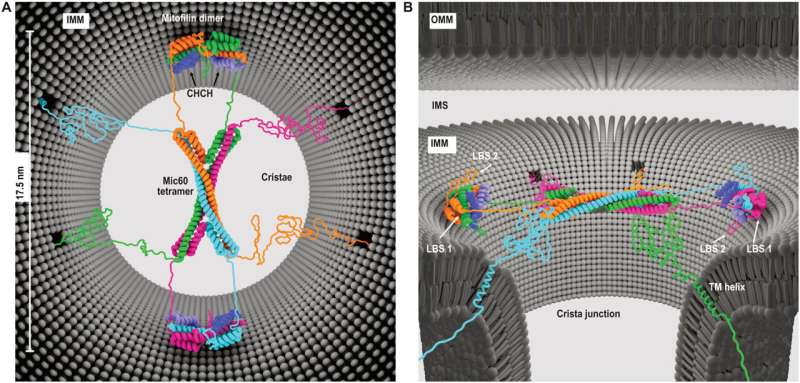Researchers describe an important component in the body's energy supply mechanism

Within the mitochondria, complex biochemical processes occur that convert the energy contained in the carbohydrates that we eat into the important energy-storage molecule ATP (adenosine triphosphate). ATP is essentially the "fuel" that powers all of the processes in living cells. If ATP production is inhibited for some reason, there can be serious consequences for the human body, including severe illness and death.
The regions in the mitochondria where ATP synthesis takes place are known as the cristae, which are folded protrusions on the inner mitochondrial membrane. "The cristae house molecular machines that act like turbines and use the controlled flow of hydrogen ions to drive ATP synthesis," explained Martin van de Laan, Professor of Medical Biochemistry at Saarland University. "This elegant mechanism can only function if the internal fine structure of the mitochondria and the formation of the cristae are continuously maintained," added Prof. van der Laan.
Working with his team and with colleagues from the Max Delbrück Center for Molecular Medicine in Berlin, van der Laan has been able to gain insights into the molecular structure of a large and complex scaffold-like protein assembly that plays an important role in controlling cristae architecture. Their results have now been published inScience Advances.
This molecular device, known as the Mitochondrial Contact Site and Cristae Organizing System (MICOS), effectively functions as the entry gate to the cristae compartments. The MICOS protein subunits Mic60 and Mic19 both have membrane-shaping capabilities and together they function like a "doorman," permitting only selected molecules to enter or exit the interior of the cristae.
The research team have now shown how the MICOS components Mic60 and Mic19 form filamentous bundles that can assemble themselves to form a vaulted molecular structure that spans the entrance to the cristae. "This dome-like assembly is elastically tethered to the mitochondrial membranes," explained Professor van der Laan. "The design and architecture of MICOS provides us with important insights into how MICOS can act as a flexible but controllable gateway into the cristae and thus regulate mitochondrial energy metabolism."
This breakthrough was possible thanks to the close collaboration between the two participating research groups who were able to successfully combine data from the structural elucidation of purified and crystallized MICOS fragments with the results of targeted functional analyses of genetically modified MICOS variants in living cells.
These groundbreaking new results have paved the way for further interdisciplinary research on this exciting topic. The follow-up studies will examine and analyze the vault-like structure that has now been identified in order to determine its significance for the structure and function of the cristae and for mitochondrial energy metabolism. Looking to the future, van der Laan added that they "are hopeful that our work will lead to other important developments, which will in turn improve our understanding of disorders arising from mitochondrial dysfunction."
More information: Tobias Bock-Bierbaum et al, Structural insights into crista junction formation by the Mic60-Mic19 complex, Science Advances (2022). DOI: 10.1126/sciadv.abo4946
Journal information: Science Advances
Provided by Saarland University



















